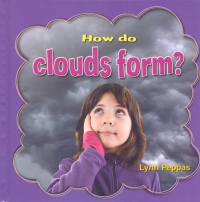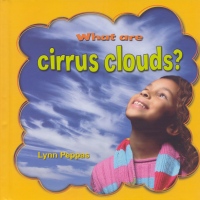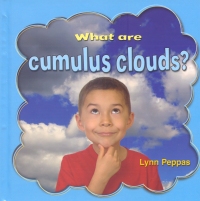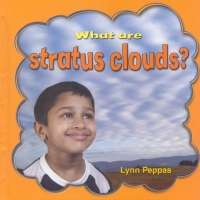| ________________
CM . . .
. Volume 19 Number 6 . . . . October 12, 2012
excerpt:
Young children are fascinated by clouds, and a number of picture books, like David Wiesner’s Sector 7, help to encourage the sense of wonder about these ephemeral objects in the sky. Lynn Peppas, the author of Crabtree’s new series, “Clouds Close-up!”, has chosen to focus on factual information about clouds and to ignore the imaginative. With the exception of the excerpt above, no mention is made of cloud gazing and seeing the shapes of reindeer, sharks, rabbits and an assortment of other animals that can be fantastic and bizarre in clouds that have names like cirrus, cumulus, and stratus. Such engagement with clouds is necessary before children’s questions about their substance, form, and origin emerge. Fortunately, the joy that can accompany children’s cloud observations is captured in a few of the photographic images of children selected for the series. The four books in the series begin with a table of contents and end on page 24 with a glossary of “Words to know”, an index, and a list of three Crabtree books and three websites where more information on weather, the water cycle, and climate can be found. The intervening 20 pages attempt to answer the question posed in the title, How do Clouds Form?, What are Cirrus Clouds?, What are Cumulus Clouds?, and What are Stratus Clouds? In each of the books, this includes one activity on pages 22 and 23 where readers are given directions for making rain, Plasticine hail, fog, or a cloud journal. The rain making in How do Clouds Form? and the fog making in What are Stratus Clouds? require access to a kettle of boiling water and very hot water, respectively, and Peppas makes clear the need for supervision by parents, caregivers, or teachers. Similar to many Crabtree publications, the “Clouds Close-up!” series makes use of stock photographic images to illustrate each page and book cover. Although these vary from book to book, duplications do occur. For example, the three books that specifically look at cirrus, cumulus, or stratus clouds use the same diagram of “The water cycle” (pp. 6-7), and the books on cirrus and stratus clouds use the same text and the same diagram that compares altitude with cloud types (pp. 10-11). All four books in the series also describe Luke Howard’s naming of clouds based on their shapes, and three of the four books illustrate what Howard meant by stratus, cumulus, and cirrus with identical photographic images. Given such replication, one can’t help but wonder why a series was chosen over a single text with the title Clouds. I also question the suitability of the series for provincially mandated curricula in science given that the reading level is Grade 2 and the interest level is Kindergarten through Grade 3. Youth in jurisdictions like Manitoba study “Weather” in Grade 5. This is the cluster where cloud formation, the naming of clouds, and the association of clouds with precipitation, severe weather, and weather forecasting are introduced. While younger learners may be helped to know about changes in state of matter and the water cycle, developing an understanding of the formation of clouds in the atmosphere, precipitation, and weather phenomena were considered too difficult, given the need to think at the microscopic and particulate levels rather than the macroscopic and what can be observed with the naked eye. Recommended with reservations. Barbara McMillan is a teacher educator and a professor of science education in the Faculty of Education, the University of Manitoba, in Winnipeg, MB.
To comment on this
title or this review, send mail to cm@umanitoba.ca.
Copyright © the Manitoba Library Association. Reproduction for personal
use is permitted only if this copyright notice is maintained. Any
other reproduction is prohibited without permission.
NEXT REVIEW |
TABLE OF CONTENTS FOR THIS ISSUE
- October 12, 2012.
AUTHORS
| TITLES | MEDIA REVIEWS
| PROFILES
| BACK ISSUES
| SEARCH | CMARCHIVE
| HOME |



